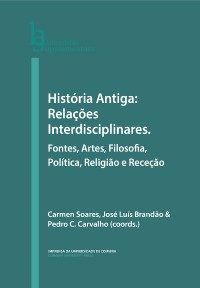Please use this identifier to cite or link to this item:
https://hdl.handle.net/10316.2/44727| DC Field | Value | Language |
|---|---|---|
| dc.contributor.author | Henriques, Luís M. Ferreira | |
| dc.date.accessioned | 2018-11-21T16:08:23Z | |
| dc.date.accessioned | 2020-09-05T01:56:19Z | - |
| dc.date.available | 2018-11-21T16:08:23Z | |
| dc.date.available | 2020-09-05T01:56:19Z | - |
| dc.date.issued | 2018 | - |
| dc.identifier.isbn | 978-989-26-1564-6 (PDF) | |
| dc.identifier.isbn | 978-989-26-1563-9 | |
| dc.identifier.uri | https://hdl.handle.net/10316.2/44727 | - |
| dc.description.abstract | From ancient Greece to the Renaissance, historiography was influenced by rhetoric, so that the historical work as well as being a repository of facts from the past, came to be understood as a literary and erudite composition. In order to docere, movere et delectare your readers, historians availed themselves of certain rhetorical mechanisms, as impressive descriptions of battles and inserting speeches in the narrative of the facts, for example. Among these speeches was the military harangue one who took over as the most characteristic of historiography, helping to build the characters of the great military strategists of antiquity, like Alexander or Caesar, multiplying a discursive typology adapted to different times of the pronunciation: before, during or after a battle. However, researchers have dedicated, above all, attention to the study of speeches delivered by the great military leaders. The truth is that ancient history provides us with numerous examples of women who also achieved renown in the performance of military duties traditionally assigned to men. In this article, so we think unprecedented, we propose to make a comparative analysis of two harangue versions of Boudica before Watling Street Battle, transmitted by Tacitus and Dio Cassius. We will focus on the analysis of the discursive typology, rhetorical topoi and gender discourse. | eng |
| dc.description.abstract | Desde a Grécia Antiga até ao Renascimento, a historiografia foi influenciada pela retórica, de tal maneira que a obra histórica, além de ser um repositório de factos do passado, passou a ser entendida como uma composição literária e erudita. A fim de docere, movere e delectare os seus leitores, os historiadores valeram-se de certos mecanismos retóricos, como descrições impressivas de batalhas e da inserção de discursos na narrativa dos feitos, por exemplo. De entre esses discursos, foi a arenga militar aquele que se assumiu como o mais característico da historiografia, ajudando na construção dos carateres dos grandes estrategas militares da Antiguidade, como Alexandre ou César, multiplicando-se numa tipologia discursiva adaptada aos diferentes momentos de pronunciação: antes, durante ou após uma batalha. Contudo, os investigadores têm dedicado, sobretudo, a atenção ao estudo dos discursos proferidos pelos grandes chefes militares. A verdade é que a historiografia antiga faculta-nos numerosos exemplos de mulheres que também alcançaram renome no desempenho de funções militares, tradicionalmente atribuídas aos homens. Neste artigo, de forma que pensamos inédita, propomo-nos fazer uma análise comparativa de duas versões da arenga de Boudica antes da Batalha de Watling Street, transmitidas por Tácito e Dião Cássio. Focar-nos-emos na análise da tipologia discursiva, topoi retóricos e no discurso de género. | por |
| dc.language.iso | por | - |
| dc.publisher | Imprensa da Universidade de Coimbra | por |
| dc.relation.ispartof | http://hdl.handle.net/10316.2/44715 | por |
| dc.rights | open access | - |
| dc.subject | rhetoric | eng |
| dc.subject | historiography | eng |
| dc.subject | military harangue | eng |
| dc.subject | gender | eng |
| dc.subject | Antiquity | eng |
| dc.subject | retórica | por |
| dc.subject | historiografia | por |
| dc.subject | arenga militar | por |
| dc.subject | género | por |
| dc.subject | Antiguidade | por |
| dc.title | Retórica e historiografia: a arenga militar feminina na Antiguidade Clássica | por |
| dc.title.alternative | Rhetoric and historiography: female military harangue in Classical Antiquity | eng |
| dc.type | bookPart | por |
| uc.publication.firstPage | 225 | - |
| uc.publication.lastPage | 238 | - |
| uc.publication.location | Coimbra | por |
| dc.identifier.doi | 10.14195/978-989-26-1564-6_12 | - |
| uc.publication.section | III. Retórica e Política | por |
| uc.publication.digCollection | PB | por |
| uc.publication.orderno | 12 | - |
| uc.publication.area | Artes e Humanidades | por |
| uc.publication.bookTitle | História Antiga: relações interdisciplinares: fontes, artes, filosofia, política, religião e receção | - |
| uc.publication.manifest | https://dl.uc.pt/json/iiif/10316.2/44727/200839/manifest?manifest=/json/iiif/10316.2/44727/200839/manifest | - |
| uc.publication.thumbnail | https://dl.uc.pt/retrieve/11015644 | - |
| uc.publication.parentItemId | 55075 | - |
| uc.itemId | 68174 | - |
| item.grantfulltext | open | - |
| item.fulltext | With Fulltext | - |
| Appears in Collections: | História Antiga: relações interdisciplinares: fontes, artes, filosofia, política, religião e receção | |
Files in This Item:
| File | Description | Size | Format | |
|---|---|---|---|---|
| retorica_e_historiografia__a_arenga_militar.pdf | 293.43 kB | Adobe PDF |  |
Items in DSpace are protected by copyright, with all rights reserved, unless otherwise indicated.
